CHALLENGING TIMES
I’ve always enjoyed using a good degree of finesse in my fishing, so I’m not a massive fan of the method, and other similar techniques that involve waiting for the rod tip to pull round. However, I don’t like sitting like a garden gnome not catching anything, so if my hand is forced, I will adapt to rigs that give me a better chance of avoiding a dry net. That happened recently when extremely cold weather slowed sport down to a virtual standstill on all local venues. Even my most trusted light line pole and running line winter rigs were failing to bring a response. During such lean times it’s always worth looking at what other anglers are doing, just in case they are making something happen. A top source of information in that area is my good friend Pete, a local bailiff who sees everything on the lakes he regularly patrols at Woodland Waters. As I mentioned in my January Diary feature, Pete is a big fan of helicopter rigs when the going is rock-hard, because they generally stir up some action.
LEARNING CURVE
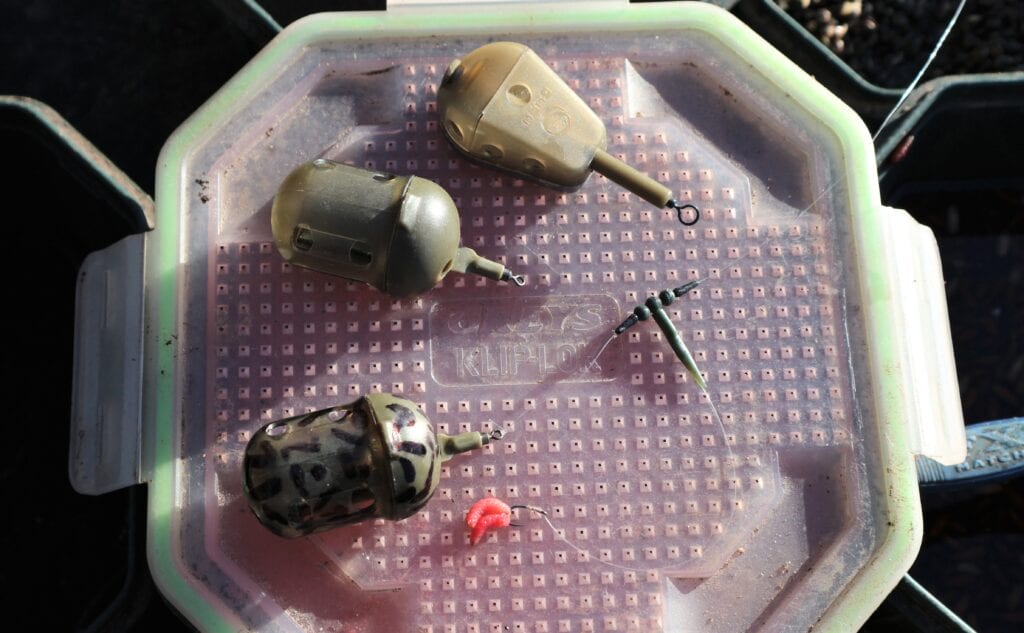

My first couple of attempts at the helicopter method failed miserably. I had bought some off-the-shelf rigs that you simply thread on your main line before attaching a feeder and short hook length. I tried these with a couple of different types of maggot feeders. Everything appeared to be working okay, except I wasn’t getting any response. Pete meanwhile was crashing out much bigger and heavier maggot blockends, and it wasn’t taking long before he was netting some cracking roach. He often uses two light specimen rods with Optonics, but is equally happy with just one feeder rod and a stiff quivertip. With the two-rod approach he casts identical large feeders a long way out, but only a few metres apart, believing the big influx of maggots brings the area to life. I suspect he switches to the one-rod tactic when he thinks it will be tougher going. I’ve sat next door while he has used both methods, and have witnessed them working when nobody else has been getting bites.
SPECIAL INGREDIENT


Try as I might, I was still struggling, while Pete was enjoying plenty of action, whether using one rod or two. Time to look a bit more closely at what he was doing. On inspecting his red maggots they had a distinct, spicy aroma about them, plus they looked nicely pumped up. It was nothing fancy, just a cheap supermarket curry powder to mask the smell of ammonia and give the fish something more attractive. Makes sense, although he insisted sprinkling a couple of tablespoons of the flavouring over the maggots a few days before gained the best results. There must be something in this, because his doctored bait was pulling plenty of takes when nothing else was happening around the lake. Such a confidence-booster seemed like a good idea to me, as I sat watching a motionless quivertip. I’ve always been a bit 50-50 about bait additives, but then again, I have favourite groundbait recipes, so maybe enhancing maggots might work in a similar fashion.
ON THE MONEY
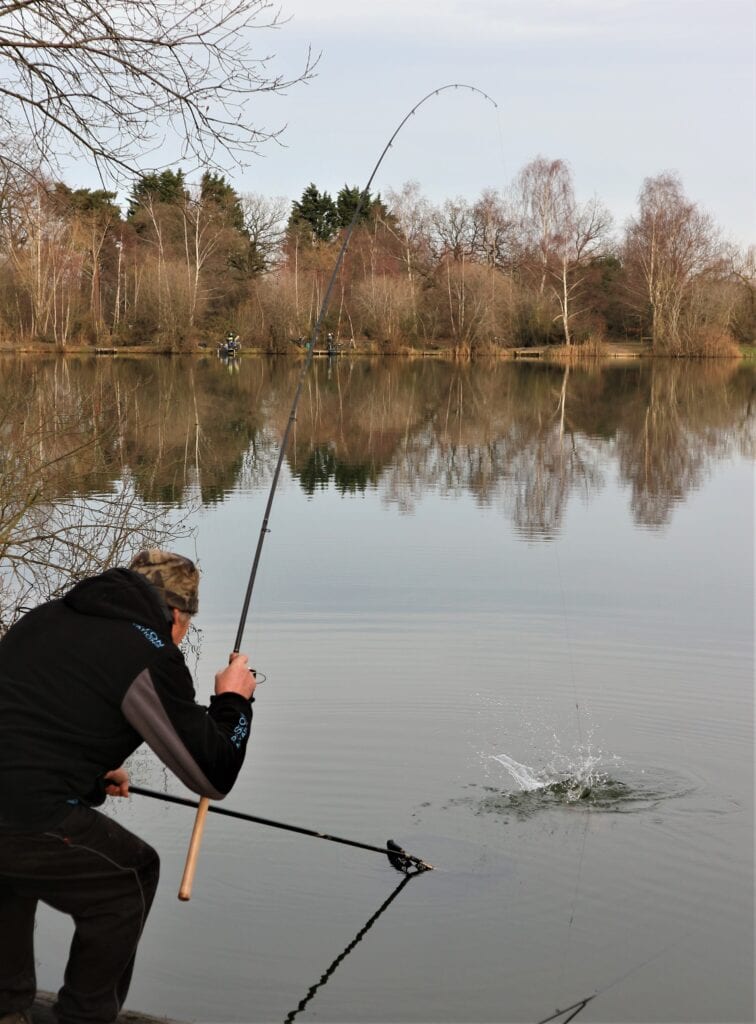

It both fascinates and niggles me that even supposedly wise old fish like big roach can fall for relatively crude tackle, while ignoring sensible light gear. This is basically what happens when heli rigs come into their own. Pete was using a ridiculously short and thick two-inch trace, and a meat hook, in comparison to what I would normally select for big red fins, yet they were hanging themselves. The more I have witnessed and thought about this, the more I realise it’s not the way you present your hook bait, it’s where you park it. It doesn’t seem to matter if a couple of maggots are attached to gear strong enough to land a tank, providing the hook bait is right on top of the feeder, amongst the free grub it’s releasing. It’s method feeder logic all over again. The fish falling for a heli set up are not stupid; it’s just a clever trap. They are used to raiding all sorts of feeder designs for free grub and normally getting away with it, only in this instance they were being properly mugged!
SERIOUS GEAR
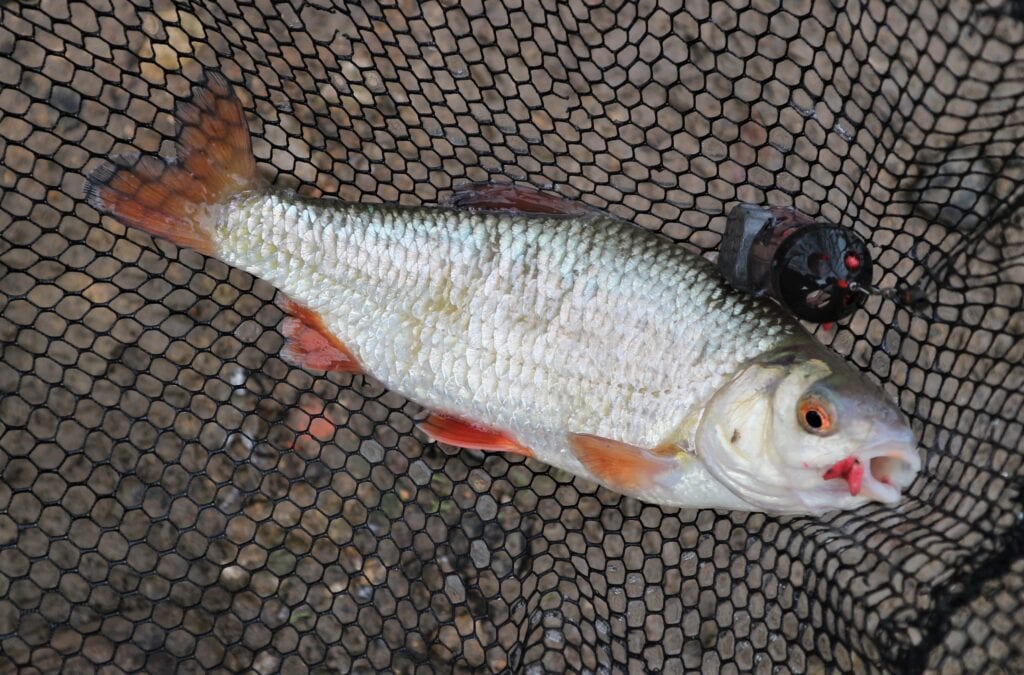

This big Black Cap Feeder, with a heavy side lead strapped to it, wouldn’t look out of place on a fast-flowing river for targeting big chub and barbel, only here it was being used on a lake! The same lake where I use crazy light gear trying to fool a similar stamp of fish to those being so easily hoodwinked on this particular occasion. Not many anglers use big blockends on this venue. Most rely on sensibly-sized groundbait, method or pellet designs, but all of these were being ignored. A fat pig of a feeder wasn’t, piling in heaps of curried grubs! Fishing never ceases to amaze me. Other anglers dotted around the water were catching nothing with their sensible feeding, and refined pole, waggler or feeder rigs. They were all watching bemused as the guy who normally collects their day-ticket money, was now grabbing all their fish too! I was just as shell-shocked as they were. I needed to have a good think about this method, but with a view to doing it in a slightly more refined way.
BEASTLY EASTERLIES
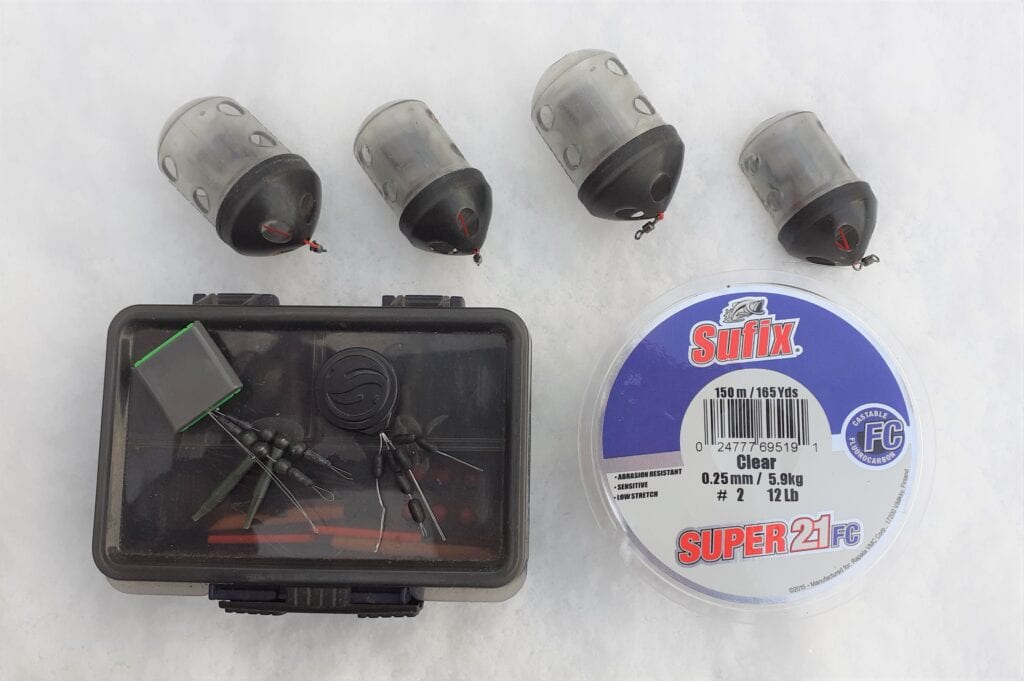

My first task getting this helicopter lark sorted was to have a good search through my tackle room, rooting out some favourite old Black Cap blockends, along with anything else that might suit the job in hand. I found some fluorocarbon, more ready-made heli rigs, and some of the new line stops that provide better grip. By this time there was snow and ice, requiring a few days for local lakes to thaw out. My first attempts at heli rigs had appeared to operate okay, but had looked a tad clumsy. I had also noticed that some of the blockend feeders I’d tried didn’t empty maggots out very quickly; one design in particular took ages to do this. I experimented with a bowl of water and found Black Caps release bait much faster than most feeders, also being easier to operate due to their soft filler caps. I also noticed you can hardly see even quite thick diameter fluorocarbon when it’s submerged in a bowl of water, plus its stiff nature is well known to help prevent short hook lengths from tangling.
WORKING OUT
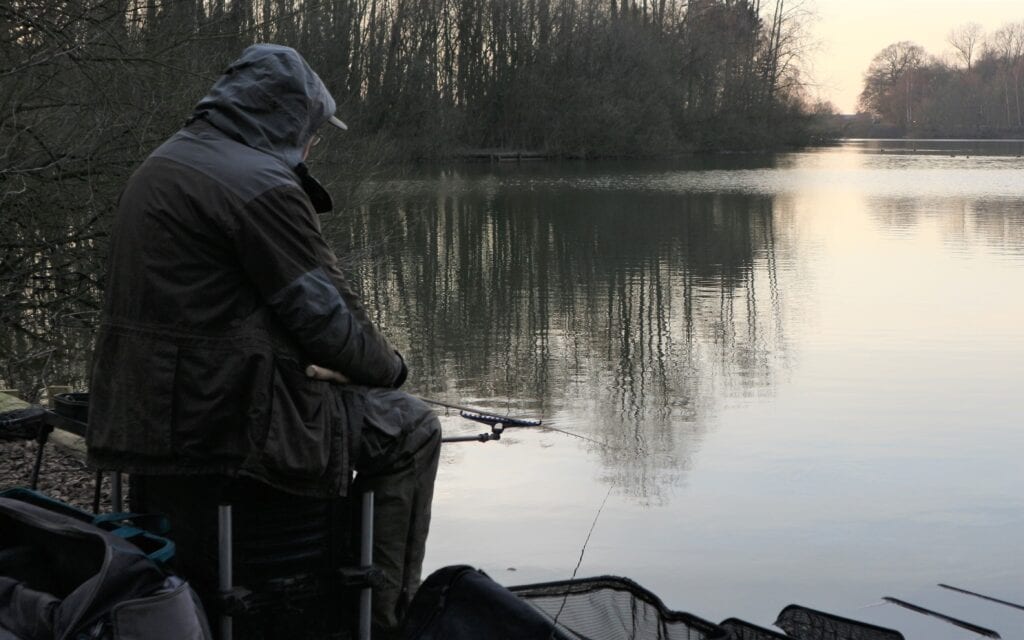

Suitably armed with curry-flavoured maggots, a good supply of blockend feeders and some new rig bits to try out, I eventually arrived on the bank again as a thaw set in. Not ideal conditions to fish lakes, when melted snow water was running into them, so this was going to be a real test for the new method I was trying to get to grips with. Pete had told me that if heli rigs were going to work, you normally got some interest after 30 to 40 minutes, when the swim has been topped up regularly. That seemed like a lot of maggots going in, at a time when the fish would be feeding less keenly than normal. I decided to use a fairly small Black Cap, also quite a light one. Anglers I had spoken to reckoned 30g feeders were about right for a bolt rig effect, combined with short hook lengths. Pete tended to go even heavier, but I wasn’t using a beefed-up rod, so a lighter 20g loading seemed okay. Also, to compensate for my toned-down approach, I tied on a longer six-inch hook length.
NUMBERS GAME
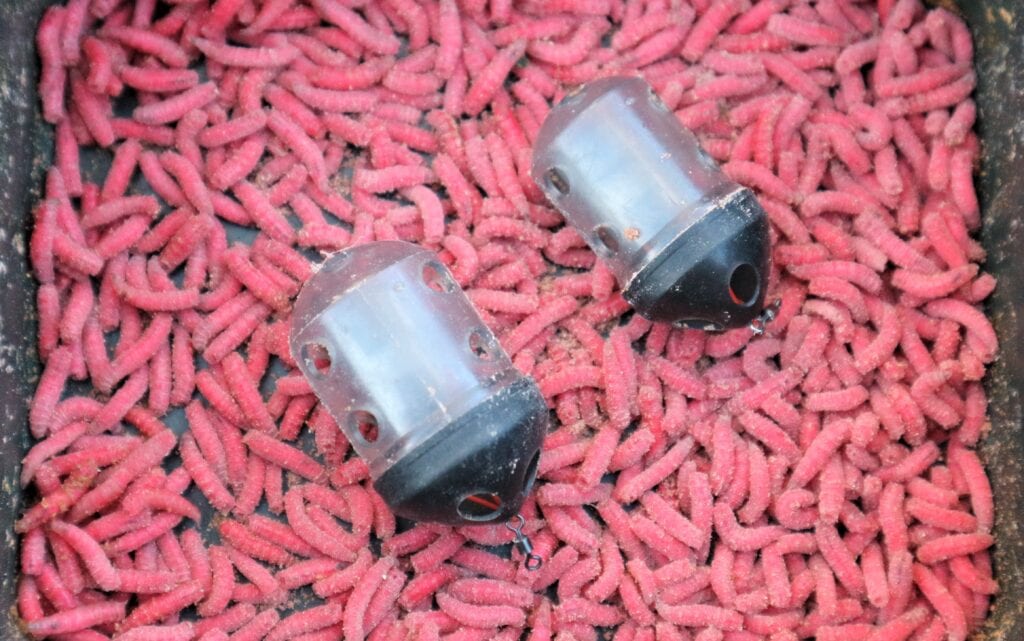

While I sat waiting for some response, I wondered how many maggots were going through my feeder each cast. Surely a few hundred? As nothing was happening, I decided to find out. With the smallest Black Cap blockend I could get 60 maggots in it loosely, or 70 if I crammed them inside. Not nearly as many as I had thought. With the next size feeder in the range, the amount increased to 80 if it was filled lightly, or 90 if the grubs were forced in. Interesting, but even more so when I started experimenting to see how quickly the maggots came out. Lightly filling a feeder resulted in everything coming out within a few seconds, also losing some bait on the cast and as the tackle descended in such deep water. Stuffing extra maggots in slowed the exit rate, meaning just about everything got to where it was intended to go, taking at least a minute for the contents to exit. With some feeder types bait didn’t come out for much longer. Black Caps were definitely best.
RIGGING RIGHT
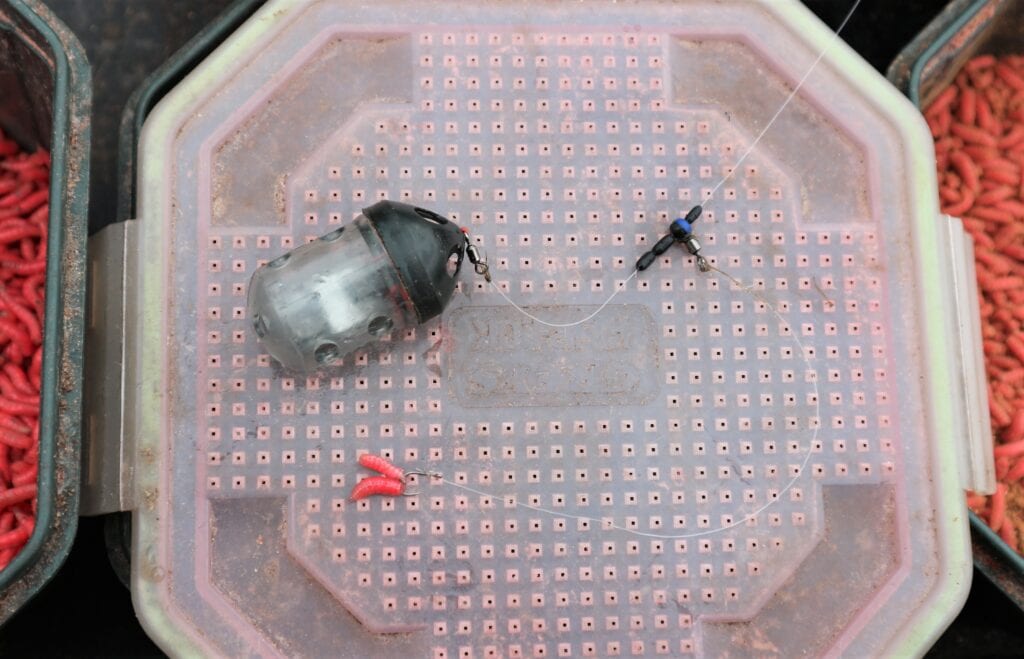

My early heli rig attempts were too fussy and components kept moving. The first problem was standard line stops slipped too easily, with everything ending up dangling above the feeder after just a few casts. Having a couple of stops next to each other helped gain better grip, but then I remembered the new extra grip stops made from firmer TPR rubber, which brands like Matrix and Guru do. You need just one of these above the rotating hook length and two below it. What you thread on in between is important too. I initially tried beads and clever gizmos that incorporated tail rubbers, but it was making my heli rigs over-complicated. Always keep things simple if you don’t want constant tangles! I found a small swivel bead to be the answer, but the important bit was the swivel needed to have a diamond eye, which helps to push the short hook length away on the cast. Finally, hook length material must be stiff. A thick diameter fluorocarbon was the answer.
TWEAKING IT
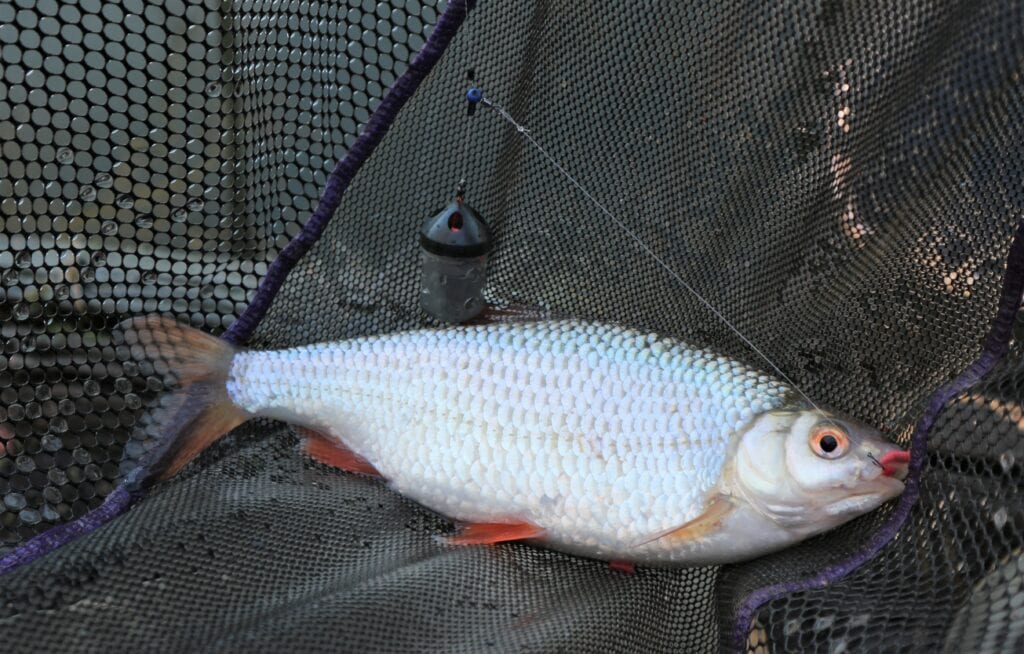

The only other thing I needed to do with my newly simplified heli rig (apart from catch some fish with it!) was experiment with hook positions. If I had my hook bait dangling right next to the feeder on the cast, it would often wrap back around the main line. I didn’t like the idea of having an extra short hook length set above the feeder, which seemed more like sea fishing to me. I wanted to use a medium-action feeder rod, not a broomstick. In the end I found a six-inch hook length was perfect, providing I set the rotating swivel bead a couple of inches above the feeder, leaving the hook bait dangling a couple of inches below it. No tangles whatsoever, plus by having a slightly longer trace, combined with a forgiving rod, the chances of hook pulls would be greatly reduced. Suddenly my quivertip came alive, rattling rather than pulling round. No strike was required, I simply lifted into the fish, a nice roach on a carp hook and short piece of rope! Very strange by my standards!
OLD TRICKS
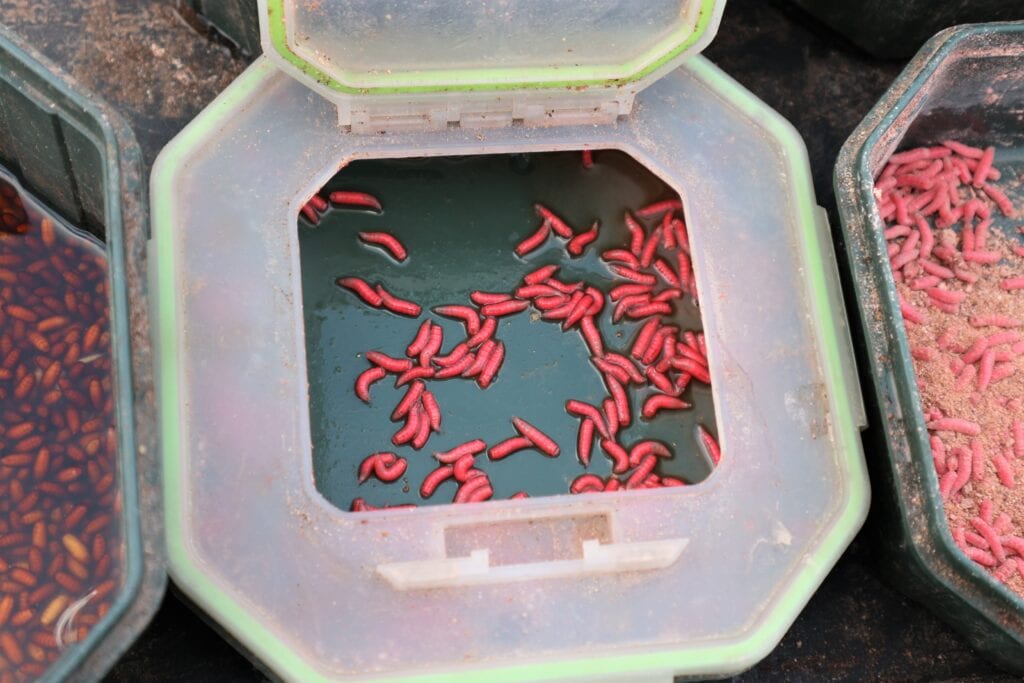

Something else I forgot to mention about my rig was the hook pattern. With a short, unforgiving, strong trace, I didn’t like the idea of a spade end design. I thought there would be a danger of a sharp spade cutting through the line, so I picked an eyed model. I also rate these for my tench fishing, finding I lose less fish when they dive into weed and the angle of the hook changes. Thinking about old tricks like that, I remembered the way I used to do well using floating maggots when fishing blockend feeders for far bank river chub. I had an escape-proof bait box with me and a handy bottle of Coke. For those who don’t know, if you want super-fast floating maggots, pour some fizzy drink over a neat handful. It only takes a few minutes to get buoyant grubs, which counterbalance the weight of the hook and act like a mini pop-up. I tried this and my quivertip came to life again. Yet another juddering take, where I suspected the fish had hooked itself. I was getting somewhere.
ALIEN TERRITORY


On a day when I managed to fine-tune a helicopter rig to the point where my swim came alive, I was of course happy to have added another string to my armoury. I looked around the lake and nothing was happening anywhere else. There was a cold Easterly wind, and some anglers were even packing up early. I felt a bit embarrassed really. I could literally sit on my hands and not miss the bites. This gave me mixed feelings, remembering those fantastic days on the same water when I had carefully nurtured swims to life, ending up catching some clonking big roach. Those Summer and Autumn evenings when the larger red fins moved up close to the surface, charging through my loose feed, even swirling on the surface. Light waggler or pole gear, set shallow, provided some special moments. Here I was now, cranking in similar-sized roach, hoping that their constant thumping against a feeder wouldn’t dislodge the hook. Not quite the same magical feeling I’m afraid.











